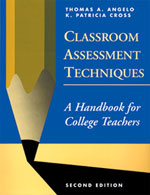How can clickers (a.k.a. PRS a.k.a. Personal Response Systems) be used effectively in the classroom? Tips for clicker use drawn from faculty experience will help; for example, explain to students why clickers are being used.
Why use clickers? Clickers can be used to find out what students are thinking, so that teaching can be tailored to where students are, and address misunderstandings. In a large class, it can be difficult to assess student thinking. Clickers can help in classroom assessment, in more ways than simply asking a factual multiple choice question to see if students can answer.
 Techniques for finding out what students are learning in the classroom and how well they are learning it are described in the canonical Classroom Assessment Techniques: A Handbook for College Teachers by Thomas Angelo and Patricia Cross. This book describes 50 classroom assessment techniques (CATs). These techniques are not tests, but rather are ways for instructors (and students) to improve learning in the classroom. Perhaps the best-known technique is the “minute paper”. An instructor using this technique would stop the class a few minutes early and ask the students to respond in writing to two questions: “what was the most important thing you learned during this class?” and “What important questions remain unanswered?”. Students write their responses anonymously and hand them in. The instructor then uses the responses from the minute papers to adjust teaching in the next class meeting. Clearly, students cannot write a minute paper on clickers. Can instructors get the same sort of information about student thinking using clickers?
Techniques for finding out what students are learning in the classroom and how well they are learning it are described in the canonical Classroom Assessment Techniques: A Handbook for College Teachers by Thomas Angelo and Patricia Cross. This book describes 50 classroom assessment techniques (CATs). These techniques are not tests, but rather are ways for instructors (and students) to improve learning in the classroom. Perhaps the best-known technique is the “minute paper”. An instructor using this technique would stop the class a few minutes early and ask the students to respond in writing to two questions: “what was the most important thing you learned during this class?” and “What important questions remain unanswered?”. Students write their responses anonymously and hand them in. The instructor then uses the responses from the minute papers to adjust teaching in the next class meeting. Clearly, students cannot write a minute paper on clickers. Can instructors get the same sort of information about student thinking using clickers?
At Educause Learning Initiative’s annual meeting, Deborah Keyek-Franssen and Charlotte L. Briggs demonstrated ways to use clickers in the classroom to assess students knowledge. They examined all 50 techniques described in detail by Angelo and Cross, and found 13 that can be used as explained and 10 that can be modified. Using clickers can faciliate CATs in very large classes and allows for an instructor to adjusting teaching to the students quickly. The list of CATs for clickers, with suggested modifications, can be downloaded from the Educause page describing their session. For example, instead of asking students to write out the “muddiest point” from class, prepare a slide with a list potential topics and include an “other” option. Ask students in multiple choice format which topic caused the most difficulty. Classroom assessment techniques will help an instructor better tailor the class activities to address student misconceptions and use class time effectively to increase student learning.
Another way to use clickers in the classroom is Peer Instruction, where students discuss concepts with, and learn from, each other. In Peer Instruction, the instructor poses a question designed to unmask common misconceptions. Students answer questions individually, then discuss their answers, forcing them to examine their own thinking before answering the question again. Research has shown that students show better conceptual learning from Peer Instruction compared with traditionally taught students, and decreases student attrition, among other benefits.
Duke instructors can contact us at the Center for Instructional Technology for ideas for effectively using clickers to meet their goals.
